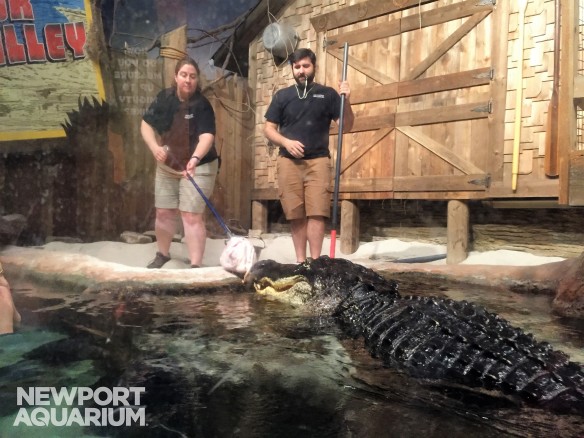Takeover Tuesday features a “day in the life” of biologists at Newport Aquarium. Be sure to follow us on Instagram, Twitter and Facebook.
My name is Erin and I am one of the biologists at Newport Aquarium! I am a Herpetologist, which means that I work with the Reptiles and Amphibians. The place you are most likely to find me is in our Frog Bog where I care for most of our amphibian collection! Come with me on this #TakeoverTuesday as I show you a day in my life!

Herpetologist, Erin, takes care of the animals in Frog Bog.
One of my jobs is to raise the next generation. These are Halmahera gecko eggs. We had Halmahera geckos running free in Canyon Falls and found these eggs when we were getting ready to start construction on the new Stingray Hideaway.

These Halmahera gecko eggs are from geckos that were running free in Canyon Falls. If these eggs hatch, the geckos will be released to run free in Stingray Hideaway.
If they hatch, we’ll release them and their parents back into Stingray Hideaway. So, keep your eyes out for geckos on the walls when we open our new exhibit this summer!
Sometimes, animals arrive too small to go into their future home. When that happens, I take care of them and help them grow up big and strong. Here is a baby Giant Musk Turtle who has a little more growing to do before he can hang out in our Shore Gallery.

Baby Giant Musk Turtle
Some of the smallest animals I care for live in the Frog Bog. These are Anthony’s Poison Arrow Frogs in multiple stages of their development, from tadpoles just getting their legs, to a brand new froglet, to two adults.
Anthony’s Poison Arrow Frogs are considered Near Threatened in the wild. Breeding efforts by Newport Aquarium and other Association of Zoos and Aquariums (AZA) institutions will hopefully keep this frog and other amphibian species off the Endangered Species List.
You may ask yourself, what does a newly hatched dart frog eat? One food we offer is called a spring tail – it’s a tiny insect.
We also give them small fruit flies and newly hatched pinhead crickets. Here at Newport Aquarium, we breed our own fruit flies and crickets so that we always have a good supply of food ready for our smallest amphibians.
Not all of the animals I take care of are tiny. I also help take care of the biggest reptiles at the aquarium, Mighty Mike our American alligator, and the rare white American alligators, Snowball and Snowflake.

Mighty Mike, the 14-foot long American alligator
They may look like statues, but believe me, they are alive. Part of taking care of them includes everyone’s favorite to watch: Feeding!

Snowball and Snowflake, rare white American alligators
During the winter, they eat every three weeks. But in the summer, they eat every week. If you are lucky, you might catch us out on the beach feeding Mike some chickens, fish, or even a rabbit or two!

Herpetologists, Erin and Ryan feed Mighty Mike.
I hope you enjoyed #TakeoverTuesday with me. Now, like this Tiger Leg Monkey Frog, it is time to rest!

Tiger Leg Monkey Frog
Check out our other #TakeoverTuesday posts








Pingback: Easter Eggs at Newport Aquarium | Aquarium Works
Pingback: National Zoo Keeper Week 2018 | Aquarium Works